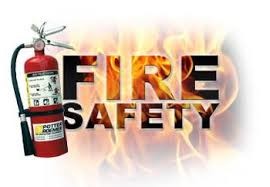October Safety Tip
Fire Safety Tips
Fire is a scary thing. Nobody knows that better than those who have experienced it firsthand. In the workplace, fire can be especially dangerous. Not only can it cause damage to the building and property, but it can also injure or kill employees. That’s why it’s important to have the following fire safety tips in place to help protect your employees in case of a fire emergency.
Evacuation Strategy
Preparing for an emergency situation is the best way to ensure your safety. The location of fire extinguishers and first aid kits should be well-known by all employees, but if that’s not the case, make sure everyone knows where the closest exit is located from their work space.
In addition, it’s important to have an evacuation strategy in case of a fire so that you can get out quickly and safely without having to worry about what you need to do next.
Having an evacuation plan helps everyone stay calm during this stressful situation so they can focus on getting out safely, instead of worrying about what to do next or how far away from danger they are at any given moment.
Safety Drills
According to the National Fire Protection Association, most fires occur in homes between the hours of 6pm and 9am, when residents are likely to be asleep. That’s why it’s important for everyone in your household to know what to do in the event of a fire.
Fire drills are an essential part of any workplace safety plan. They provide employees with the chance to practice their emergency response in a safe environment and can help assure that their response is fast and effective if a real emergency occurs.
We recommend running through fire drills at least twice a year, though the more frequent practice is better if possible. In addition to practicing the drill itself, it’s also important to review what each employee should do in case of an emergency during the drill itself. This can be done by having managers or supervisors walk around during the drill and ask people what they would do in that situation.
No Smoking/Designated Smoking Area
When it comes to smoking inside buildings, there are a few things to keep in mind. First and foremost, always be aware of where the designated smoking areas are. This will help reduce the risk of potential fires and help maintain the safety of the building. Secondly, be sure to properly dispose of any cigarette butts or ashes. Failure to do so could result in a fire. Finally, if you smoke near any flammable materials, be sure to extinguish your cigarette completely to avoid the risk of starting a fire.
Smoke Alarm & Sprinkler Installation
The best way to protect your building and its occupants is to install a working sprinkler system and smoke alarm.
It’s a necessity to have a working smoke alarm and sprinkler system in every building, but you also need to test them often to ensure they work. If you haven’t tested your smoke alarms recently, it’s time.
You should test your smoke alarm once a month by pushing the button on the side of the alarm. You should also check that there are no issues with your wiring or installation, which could cause problems in the future. If you’ve never installed a sprinkler system before, we recommend calling an expert before proceeding; some systems can be tricky to install correctly.
Maintain Machinery
It is important to check all the equipment in the building often to make sure they are working properly. This includes any electrical machines that could overheat and cause a fire. These fires can seriously damage or even destroy your property, so it is important to check them often and make sure they are working correctly.
Equipment Accessibility
Fire-related panels and equipment should be easily accessible. It’s important to make sure the area around them is clear so that employees can shut off the power if needed. In addition, it’s important to make sure all fire-related panels and equipment are labeled clearly with their correct purpose.
The following guidelines will help you ensure your facility is ready for any emergency:
- The area around fire-related panels and equipment should be clear of any obstructions. This includes furniture, materials, and other items that could get in the way of employees trying to access these areas during an emergency.
- All fire-related panels and equipment must be labeled clearly with their correct purpose so employees know how to operate them during an emergency situation. Having a visual guide available during non-emergency times can also help employees remember what each panel does in case they’re ever needed during an emergency situation!
Fire Extinguisher
According to the National Fire Protection Association, more than 3,000 fire extinguisher-related injuries have been reported over the last five years. That’s why it’s important to make sure your employees know how to use them correctly—and that they’re accessible in case of an emergency.
If you’ve never done this before, here are a few tips:
- Check the gauges on your fire extinguishers. You want to make sure the extinguishers are fully charged and easily accessible. Also, be sure to test them and train employees on how to properly use them. If your employees need more information or training, find a qualified instructor who can teach them how to use them correctly!
- Make sure that all fire alarms are in good working order and that they’re set up correctly in accordance with local laws and regulations. If there’s any doubt about whether an alarm will work properly, replace it! It’s better safe than sorry when it comes down to protecting lives and property in case of fire emergencies!
Look Out For Electrical Hazards
It’s important to make note of any electrical hazards. If you discover any issues, contact an authorized repairman immediately. Malfunctioning electrical equipment is a leading factor in fires in the workplace.
Electrical hazards can be dangerous for both employees and customers. If you come across a malfunctioning electrical outlet or another issue with the wiring, here are some tips for handling it:
- Contact an authorized repairman immediately.
- Make sure that the area around the wiring is kept clear of clutter and other objects so that there’s nothing that could catch fire if there were a short circuit or overheating problem with the wiring itself.
- If you notice anything unusual about the way your power is being used (e.g., if lights are flickering or going out unexpectedly), report it right away so that an expert can come to inspect it before any damage occurs!
Safely Store
When it comes to storing hazardous waste, the best place is in a metal container. This is because metal containers are non-conductive, which means they will not spark if they come into contact with flammable materials.
It’s also important to make sure you empty your metal container frequently. If you leave hazardous materials in an unsecured space for too long, there’s a chance that someone could get hurt or even die from exposure to the materials.
Know What To Do If You’re Trapped
If you are in an emergency situation and can’t get out of the office due to a fire, don’t panic. In addition, the best thing to do is stay far away from the fire, seal all cracks in the room and yell for help out a window.
If there is no other way to exit the building, take shelter in a small room or closet with thick walls—like your office bathroom. Make sure you close the door behind you and turn off all fans or air conditioning systems. Make sure there are no gaps around windows or doors that might allow smoke into your safe place. If there’s no air conditioning system running in your area, plug some holes with towels or clothing to keep smoke from coming through cracks in walls or windows. If possible, tape up any vents where smoke might come through as well.
If there is smoke coming into your room through vents or gaps around windows/doors, cover your mouth with a cloth and try not to breathe in any smoke while waiting for firefighters to arrive on the scene. If possible, seal off any gaps using items such as clothing or towels that aren’t too flammable (so they won’t catch on fire).

